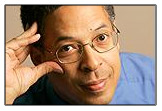Cultural Conversations – January 14, 2010
“Communication is more about what the listener hears than what the speaker says.” What is a “code word” and is it an actual word or the context? How do we know if we are using them – or if someone else is? How do we get past the language to communication?
Media personalities Lewis Diuguid, leading columnist and member of the Editorial Board of The Kansas City Star and Mary O’Halloran, nationally-recognized speaker and commentator who appears on KCPT’s Ruckus shared their personal experiences and professional opinions Over twenty people joined the speakers around an extended table to hear the presenters’ stories and add their own comments in an examination of intercultural communications: how we communicate, what words we use, and what they mean – both to speaker and to listener.

Mary O’Halloran opened the evening’s discussion by challenging the group to “go beyond being comfortable” with each other and reach “cultural capability” – that communication must be among cultures in politics, health and commerce as well as in society. Ms. O’Halloran said, “We need a new face in America, which incorporates all the faces of America.” Community, she added is an issue that can unite or divide. She also stressed that “code words” are used to divide men and women, not just cultures and used the common instance of when a man (usually a young man but sometimes an older man) will address a mature woman as “young lady” – when it is obvious that the woman being addressed is middle-aged or older.
Globalization is creating fewer languages, a fact recognized by the UN’s declaration of 2008 as the “year of the language” to promote consciousness of the power of language. Ms. O’Halloran quoted communications writer Deborah Tannen (“The biggest mistake is believing that there is only one way to have a conversation.”) and cautioned that we need to be aware of how our speech patterns affect people.
 Lewis Diuguid brought several publications as examples of “code words” used in articles and news reports over the past few years He also shared the personal experience of having recently attended a gun show with several members of a diversity discussion group and quipped ”I never saw so many pickups and so many white men.’’ This example was raised to show that “guns” and “pickups” are examples of code words because their use instantly conjures a certain stereotype of the type of person who would attend such an event.
Lewis Diuguid brought several publications as examples of “code words” used in articles and news reports over the past few years He also shared the personal experience of having recently attended a gun show with several members of a diversity discussion group and quipped ”I never saw so many pickups and so many white men.’’ This example was raised to show that “guns” and “pickups” are examples of code words because their use instantly conjures a certain stereotype of the type of person who would attend such an event.
Mr. Diuguid pointed out that code words are “trigger” words that evoke ideas of “them” and “us” and promote the idea that certain people are in a different “camp” than we are, that they think differently and act differently.
As examples of “us and them” thinking, he mentioned that the NAACP, which will hold a national conference in Kansas City in July of 2010, has stated, in it’s 100-year-old magazine The Crisis, that Affirmative Action is part of a code and that President Obama has now become part of that
code. He directed attention, too, to recent newspaper and television pieces highlighting the crime statistics in a particular ZIP code, as an example that even addresses can be considered code words, as can a school district (“Blue Valley” or “Kansas City”), a name (e.g., “TaMika” or “Tammy”) or a method of transportation (e.g., the idea that only persons of a certain socio-economic status would ride public transportation).
The term used in the past “cultural competency” assumes that we have some knowledge of another’s culture. Mr. Diuguid opined the need for a new term: “cultural humility” – a concept that an individual should be humble and admit ignorance of another culture and intend to learn from the individuals within that culture.
He also raised the idea of the “Platinum Rule” — Do unto others as they would prefer we do unto them. The Golden Rule assumes one’s own culture is best and that we know best what another person needs. The Platinum Rule means we have to learn from others.
Both speakers stressed the importance of having teachers and leaders who mirror the general population….that media and schools must have educators and reporters who correspond to their constituencies. Today, forty-five percent of pre-school age children are children of color but the percentage of teachers does not mirror that figure.
In the open discussion session, following the formal presentations, those in the audience raised thought-provoking questions and comments. The discussion ended with the observation that policy does not change in a vacuum and raised the question — what role do citizens play? While there are many possible answers to that question and many variables for individual action, one thing appears certain – discussions like Cultural Conversations provide an opportunity for people to come together from different areas and cultures and meet on “common ground” to discuss the issues that are so important for us all.


Leave a comment